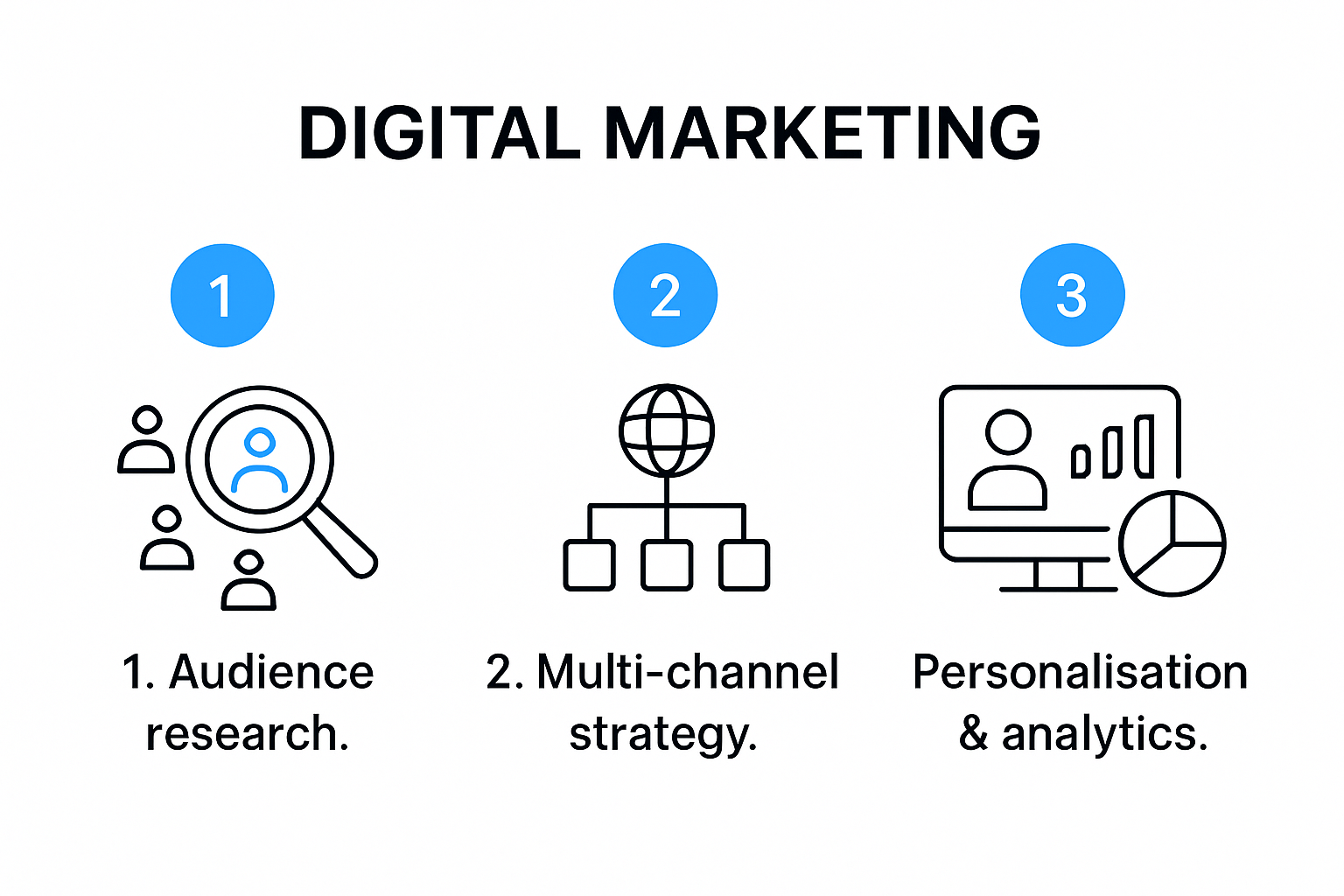Digital marketing is changing faster than ever. In 2025, over 80 percent of businesses will use artificial intelligence for advanced personalization and predictive insights. Most people expect new tech to make things too complicated or push small brands aside. But smart strategy is turning this chaos into real connections and growth, making digital marketing in 2025 more human than anyone imagined.
Table of Contents
- The Core Elements Of Digital Marketing
- Choosing The Right Channels For Your Business
- Digital Marketing Strategies For Growth In 2025
- Measuring Success And Adapting To Change
Quick Summary
| Takeaway | Explanation |
|---|---|
| Define Your Audience Clearly | Conduct thorough research to create detailed audience personas based on demographics and behaviours. This helps in tailoring marketing strategies effectively. |
| Integrate Multiple Channels | Implement a seamless multi-channel strategy to ensure consistent messaging across platforms and enhance customer touchpoints. |
| Embrace Advanced Personalization | Utilize AI technologies to create hyper-personalized customer experiences that predict needs and tailor content dynamically. |
| Adopt Predictive Analytics | Leverage data-driven insights to anticipate market trends and customer behaviours for more proactive marketing strategies. |
| Measure with Holistic Metrics | Focus on comprehensive KPIs like customer acquisition cost and lifetime value to evaluate overall marketing performance and drive sustainable growth. |

The Core Elements of Digital Marketing
Digital marketing represents a dynamic ecosystem of strategic communication and engagement tactics designed to connect businesses with their target audiences through digital channels. Understanding the fundamental elements enables organisations to craft powerful, targeted strategies that drive meaningful results.
To help visualise the major components, the table below summarises the core elements discussed in this section and their primary focus:
| Core Element | Description | Key Focus |
|---|---|---|
| Strategic Planning & Audience Definition | Setting objectives and understanding detailed personas | Research & segmentation |
| Content & Channel Strategy | Developing meaningful content and choosing best-fit platforms | Value-driven communication |
| Performance Measurement & Optimization | Tracking KPIs and refining campaigns based on insights | Data-driven improvement |
Strategic Planning and Audience Definition
Successful digital marketing begins with meticulous strategic planning. According to the Digital Marketing Institute, effective strategies involve establishing clear objectives across multiple stages: awareness, consideration, conversion, and retention. These objectives form the foundation of a comprehensive digital approach.
Business leaders must first conduct thorough audience research to understand demographic characteristics, online behaviours, preferences, and pain points. This involves creating detailed audience personas that go beyond basic demographic information. Advanced segmentation techniques allow marketers to develop nuanced strategies tailored to specific customer groups.
Content and Channel Strategy

Content remains the cornerstone of digital marketing effectiveness. Google’s Grow with Google program emphasises the critical importance of developing valuable, relevant content that resonates with target audiences. This means creating multimedia assets that address specific customer needs across various digital platforms.
Channel selection is equally crucial. Businesses must strategically choose digital platforms that align with their audience’s preferences. This might include social media networks, email marketing, search engine marketing, content marketing, and emerging channels like podcast advertising. The key is creating an integrated approach where different channels complement and reinforce each other.
Performance Measurement and Optimization
Digital marketing’s unique strength lies in its measurability. Unlike traditional marketing approaches, digital strategies provide granular insights into campaign performance. Wikipedia’s comprehensive overview highlights multiple measurement techniques including search engine optimization (SEO), data-driven marketing, and advanced analytics.
Marketers should implement robust tracking mechanisms that capture key performance indicators such as engagement rates, conversion metrics, return on investment, and customer acquisition costs. Regular analysis allows continuous strategy refinement, ensuring marketing efforts remain responsive to changing market dynamics and audience preferences.
Implementing these core elements requires a holistic approach that balances strategic thinking, creative content development, and data-driven optimization. By understanding and effectively executing these fundamental components, businesses can create digital marketing strategies that genuinely connect with their target audiences and drive sustainable growth.
Choosing the Right Channels for Your Business
Selecting the appropriate digital marketing channels is a critical strategic decision that can significantly impact a business’s online success. Each channel offers unique opportunities and challenges, making thoughtful selection essential for maximising marketing effectiveness and return on investment.
The table below provides a comparison of key digital marketing channels mentioned in the article, their strengths, and best audience alignment to help guide channel selection decisions:
| Channel | Strengths | Best For |
|---|---|---|
| Social Media | Immediate interaction & high engagement | Broad/younger/visual audiences |
| Email Marketing | Personalised direct communication | Relationship-building, follow-up |
| Search Engine Marketing | Intent-based targeting | Audiences actively seeking info |
| Content Marketing | Authority & trust-building content | Education & long-term nurturing |
| Podcast Advertising | Engaged, niche communities | Interest-based audience segments |
| Professional networking, B2B targeting | Professional, business sectors | |
| Instagram/Pinterest | Visually-driven content | Creative/visual/product-focused brands |
Understanding Channel Characteristics and Audience Alignment
Channel selection begins with comprehensive audience research and understanding. The American Marketing Association recommends a strategic approach that considers audience demographics, behaviour patterns, and platform preferences.
Businesses must conduct thorough audience mapping to identify where their target market spends time online. This involves analyzing age groups, professional backgrounds, interests, and digital consumption habits. For instance, professional services might find more traction on LinkedIn, while creative industries could benefit from visually driven platforms like Instagram or Pinterest.
Consider factors such as platform engagement rates, user demographics, content format compatibility, and potential reach. Each digital channel presents distinct advantages social media platforms offer immediate interaction, search engine marketing provides intent-based targeting, while email marketing enables personalised communication.
Strategic Multi-Channel Integration
A sophisticated digital marketing strategy goes beyond selecting individual channels. According to groundbreaking research on cross-channel marketing, businesses should adopt an integrated approach that creates seamless experiences across multiple platforms.
Multi-channel integration involves:
- Consistent Messaging: Maintaining brand voice and core communication across different platforms
- Strategic Content Adaptation: Tailoring content format and style to suit each channel’s unique characteristics
- Cross-Platform Analytics: Implementing tracking mechanisms that provide holistic performance insights
This approach ensures that marketing efforts create a cohesive narrative, regardless of where potential customers encounter your brand. The goal is to create multiple touchpoints that guide prospects through the customer journey, reinforcing brand messaging and increasing conversion probability.
Performance Measurement and Channel Optimization
Continuous performance evaluation is crucial for effective channel management. Businesses must implement robust analytics frameworks that track key performance indicators specific to each digital platform.
Important metrics include engagement rates, conversion percentages, cost per acquisition, and return on investment. Regular analysis allows marketers to:
- Identify high-performing channels
- Reallocate resources from underperforming platforms
- Experiment with emerging digital marketing opportunities
- Refine targeting strategies based on empirical data
Successful digital marketing requires flexibility and a willingness to adapt. By maintaining a data-driven approach to channel selection and continuously optimizing strategies, businesses can create powerful digital marketing ecosystems that effectively reach and engage their target audiences.
Remember that channel selection is not a one-size-fits-all process. What works for one business might not work for another. Continuous learning, experimentation, and strategic refinement are key to developing a robust digital marketing approach that drives meaningful business results.
Digital Marketing Strategies for Growth in 2025
The digital marketing landscape continues to evolve rapidly, presenting businesses with unprecedented opportunities and challenges. As we approach 2025, successful marketing strategies will demand innovative approaches that leverage advanced technologies, prioritize personalization, and create meaningful customer connections.
Advanced Personalization and AI Integration
Personalization is no longer a luxury but a fundamental expectation for modern consumers. According to Forbes Business Council, businesses must focus on creating hyper-personalized experiences that go beyond basic demographic targeting.
Large Language Models (LLMs) are revolutionizing marketing capabilities. Research from advanced technological studies demonstrates how these sophisticated AI systems can generate highly targeted content, predict customer behaviours, and create more nuanced marketing communications. This technology enables businesses to develop:
- Intelligent Content Generation: Creating contextually relevant marketing materials
- Predictive Customer Insights: Understanding potential customer needs before they articulate them
- Automated Personalization: Tailoring experiences in real-time across multiple digital touchpoints
Emerging Search and Interaction Technologies
The way consumers search and interact with digital content is undergoing significant transformation. Voice search and visual search technologies are becoming increasingly sophisticated, requiring marketers to adapt their strategies accordingly.
Businesses must optimize their digital presence for multiple search modalities. This involves:
- Developing content that works seamlessly with voice-activated devices
- Creating visually rich, searchable content
- Implementing structured data that enhances discoverability across different search platforms
Marketing teams need to think beyond traditional keyword strategies and consider more natural, conversational search patterns. This means developing content that answers specific questions and provides genuine value to users.
Data-Driven Strategic Attribution
Advanced analytics and sophisticated attribution models will be crucial for understanding marketing performance in 2025. Businesses must move beyond simplistic measurement approaches and develop comprehensive frameworks that capture the entire customer journey.
Key considerations include:
- Implementing multi-touch attribution models
- Leveraging advanced machine learning for predictive analytics
- Creating holistic views of customer interactions across multiple channels
Ethical considerations remain paramount. While leveraging advanced technologies, businesses must prioritize data privacy, transparency, and responsible use of customer information. This means developing clear data governance strategies and maintaining trust with consumers.
The most successful digital marketing strategies in 2025 will balance technological innovation with genuine human connection. By embracing advanced technologies while maintaining a focus on creating meaningful customer experiences, businesses can develop powerful, adaptive marketing approaches that drive sustainable growth.
Measuring Success and Adapting to Change
In the dynamic world of digital marketing, success is not a static destination but a continuous journey of measurement, analysis, and strategic adaptation. Businesses must develop robust frameworks that enable them to track performance, interpret data, and pivot quickly in response to changing market conditions and emerging opportunities.
Key Performance Indicators and Holistic Measurement
Effective performance measurement goes beyond simplistic metrics. Harvard’s Digital Marketing Strategy program emphasizes the importance of developing comprehensive measurement approaches that align with broader business objectives.
Critical performance indicators businesses should track include:
- Customer Acquisition Cost: Understanding the financial investment required to attract new customers
- Conversion Rates: Measuring the percentage of potential customers who complete desired actions
- Customer Lifetime Value: Assessing the long-term economic value of customer relationships
- Engagement Metrics: Tracking interactions across different digital platforms
These metrics provide a multidimensional view of marketing performance, enabling businesses to make data-driven decisions that drive sustainable growth.
Predictive Analytics and Strategic Adaptation
Advanced technologies are transforming how businesses approach performance measurement. Research exploring AI-driven marketing strategies highlights the potential of predictive analytics to revolutionize strategic decision-making.
Predictive analytics enables businesses to:
- Anticipate market trends before they fully emerge
- Identify potential customer behaviours and preferences
- Develop proactive marketing strategies
- Optimize resource allocation more effectively
This approach shifts marketing from a reactive to a predictive model, allowing businesses to stay ahead of changing market dynamics.
Continuous Learning and Organizational Agility
Successful digital marketing requires more than just tracking metrics. Businesses must cultivate a culture of continuous learning and rapid adaptation. This means creating organizational structures that can quickly interpret data, experiment with new approaches, and implement insights rapidly.
Key strategies for maintaining marketing agility include:
- Regular performance reviews
- Cross-functional collaboration
- Investment in ongoing team training
- Developing flexible technological infrastructure
- Creating feedback loops that enable quick strategic adjustments
The most successful businesses will be those that view measurement not as a compliance exercise, but as a strategic opportunity for innovation and growth. By developing sophisticated measurement frameworks, leveraging advanced technologies, and maintaining organizational flexibility, businesses can transform data into a powerful competitive advantage.
Ultimately, measuring success in digital marketing is about creating a dynamic, responsive approach that balances quantitative insights with qualitative understanding. It requires a nuanced perspective that sees metrics not as endpoints, but as starting points for strategic exploration and continuous improvement.
Frequently Asked Questions
What are the core elements of digital marketing?
Digital marketing consists of three core elements: strategic planning and audience definition, content and channel strategy, and performance measurement and optimization. These components help businesses create targeted strategies for effective engagement with their audience.
How can I choose the right digital marketing channels for my business?
To select the right channels, conduct thorough audience research to understand where your target market spends their time online. Consider factors like demographics, platform engagement rates, and content format compatibility to align your strategies with audience preferences.
Why is advanced personalisation important in digital marketing for 2025?
Advanced personalisation is crucial as customers increasingly expect tailored experiences. Leveraging AI technologies allows businesses to deliver highly personalised content and predict customer needs, enhancing user engagement and conversion rates.
How can I measure success in digital marketing?
Success can be measured using key performance indicators (KPIs) such as customer acquisition cost, conversion rates, and customer lifetime value. Employing predictive analytics can also help businesses anticipate trends and adapt strategies for better results.
Transform Your Digital Strategy Into Real Results
You have seen in this article how fast-changing digital marketing can leave businesses struggling to keep up. Many brands today feel overwhelmed by shifting technology, complex customer journeys, and the demand for personalised experiences. The pressure to adapt content across multiple channels, measure success with advanced analytics, and deliver seamless online interactions is greater than ever. If your company is concerned about staying ahead with these evolving trends or wants to unlock the true power of advanced web solutions matched to your business goals, you are not alone.
Cloudfusion bridges this gap by offering end-to-end web design, branding, and digital marketing solutions for forward-thinking businesses. Our team helps you move from strategic planning and audience research straight through to content creation and multi-channel execution, built entirely around your specific needs and market. Are you ready to take control of your digital future and turn practical strategies into measurable business growth?
Start here for a tailored approach to web design and development that fits the demands discussed in this article. Visit our website and request your quotation now. Experience how Cloudfusion can help you blend sophisticated technology with strategic marketing for real impact.








